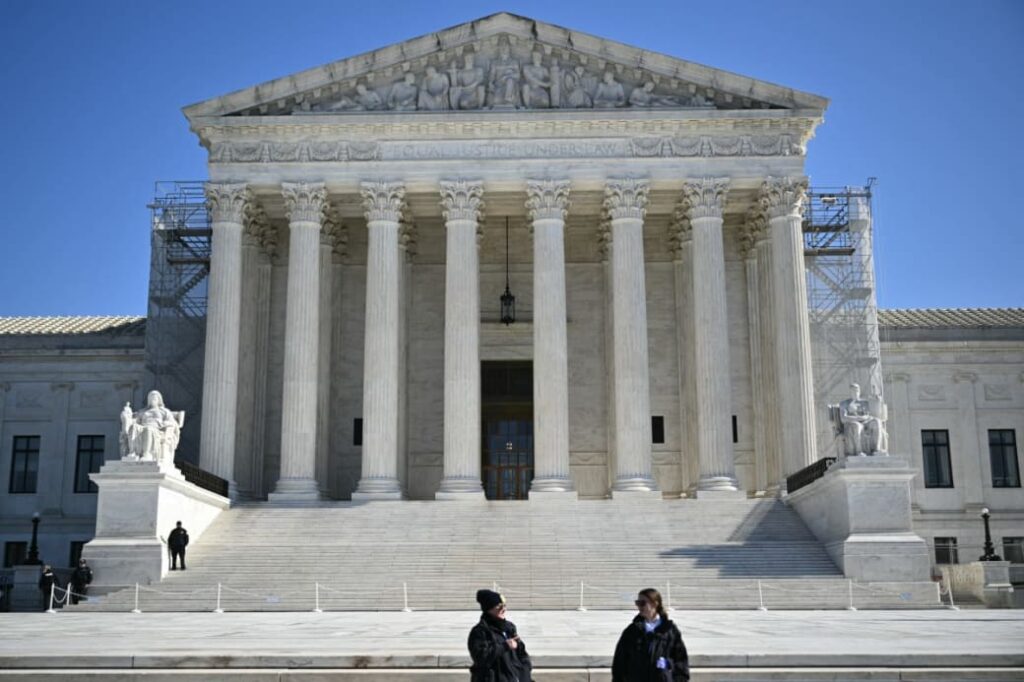
Oral arguments are scheduled to be heard by the U.S. Supreme Court on Wednesday in a case that holds significant implications.
The outcome will determine the fate of a ban on a device that was tragically used in the 2017 Las Vegas mass shooting, resulting in the loss of numerous lives and causing severe injuries to many others.
In a departure from the usual gun rights cases that revolve around the Second Amendment, this particular case delves into the question of whether the Bureau of Alcohol, Tobacco, Firearms and Explosives (ATF) had the power to prohibit bump stocks in 2018.
After the tragic Las Vegas shooting, which was the deadliest in modern US history, the former President Trump took action by instructing the Justice Department to prohibit the use of devices that can transform legal weapons into machine guns.
In 2018, Texas gun shop owner Michael Cargill raised a challenge to the ban, stating that the move disregarded federal law. The case underwent review by multiple lower courts before reaching Washington.
“It’s crucial to have the decision-making power in the hands of Congress, rather than the ATF,” expressed Mark Chenoweth, president and chief legal officer of the New Civil Liberties Alliance, the organisation leading the challenge against the ban.
Bump stocks are devices that enable a semiautomatic firearm to discharge multiple shots with a single trigger pull, utilising the recoil energy of the firearm. They gained widespread attention when it was discovered that the Vegas shooter had utilised one, sparking a movement to prohibit their use.
However, those who oppose the ban argue that the ATF exceeded its authority, while the Biden administration and its supporters stand by the decision, asserting that regulators made the correct choice.
According to attorney Billy Clark, from the gun-safety group Giffords, the bump stock rule is a matter of common sense.
According to The Associated Press, bump stocks were created in the early 2000s as one of several devices that emerged after the expiration of the federal assault weapons ban in 1994. The Justice Department stated their intention to recreate the capability of automatic fire in rifles, while ensuring that these firearms are not transformed into ‘machineguns’.
This stance remained unchanged until Trump requested the DOJ to reevaluate the policy following the tragic incident in Las Vegas.
Critics of the ban argue that bump stocks do not transform rifles into machine guns, as the shooter still needs to exert pressure on the trigger to maintain continuous firing.
On the other hand, the government has pointed out that regular machine guns also necessitate the shooter to apply pressure on the trigger. They contend that since the shooter’s finger remains stationary while firing, firearms equipped with bump stocks fall within the legal definition of a machine gun.
As reported by The Associated Press, approximately 520,000 bump stocks were in circulation when the ban was implemented in 2019. Those in possession of these devices were obligated to either surrender or destroy them. According to court records, the plaintiffs claimed to have suffered a significant loss of approximately $100 million.
The challenge to the bump stock ban encountered varying opinions as it made its way to the Supreme Court. A three-judge panel from the Washington, D.C. federal appeals court has recently upheld the ban, stating that a bump stock enables a shooter to fire multiple shots with a single trigger pull.
Nevertheless, the 5th Circuit Court of Appeals in New Orleans delivered a verdict against the ban, stating that bump stocks do not meet the criteria of machine guns as outlined in the National Firearms Act and Gun Control Act. The Supreme Court has received an appeal regarding this ruling.
It is anticipated that the justices will reach a verdict in the case by early summer.





More Stories
China Launches a Moon Mission as the US and China Ratchet up their Space Rivalry
Court finds Government’s Climate Strategy illegal
Sales of Apple iPhones Decline in Almost Every Nation